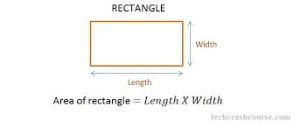22 Pan Size Adjustments
Sometimes you might want to increase or decrease a batter recipe, and when you do that, you will have to adjust the pan size as well. The first thing you need to do is to find the area of the pans you are using. For a square or rectangular pan, you simply multiply the length times the width. For example, an 8-inch pan has an area of 8 8, or 64 square inches. A 13 by 9 inch pan has an area of 13
9, or 117 square inches.

Finding the area of a round pan is a little more complicated. For example, an 8-inch round pan has a diameter of 8 inches, but to find the area you need to use the radius, which is one half of the diameter, or 4 inches.

To find the area of a circle, you multiply the radius times the radius times 3.14 (pi). So the area of an 8-inch round pan is 4 4
3.14, or 50.24 square inches. (Notice that this is less than the area of an 8-inch square pan!)
What if you want to increase a recipe for an 8-inch square pan to fit into a 13 by 9 inch pan? Now you can use a conversion factor to get an approximation of how you need to adjust the recipe. Remember that 
The new yield would be the new pan area of 117 square inches, and the old yield would be the old pan area of 64 square inches.
= 1.828 . . . or 1.83, rounded to the nearest hundredth. You might use 1.83 as your conversion factor for the recipe. However, often the conversion factor will give some impossible numbers. For example, 2 cups of flour times 1.83 would give you 3.66 cups of flour and
cups milk would give you 3.202 . . . cups of milk. It will often be easier to approximate the conversion factor and adjust your baking time and temperature. In this case, a conversion factor of 1.75 might be easier to use.
This puts an anchor at the top of the page to link to within the page.
This is the Navigation section at the top of the page.
Assignment
Purpose
To practice calculating pan area and adjusting recipes for pan size.
Outcomes
By completing this assignment, you will be able to…
- Correctly calculate the area of different pan sizes.
- Correctly calculate the conversion factor for adjusting pan sizes.
Instructions
To complete this assignment…
- Read the problems carefully and find the correct answers.
- Be sure to show how you set up each problem.
Tips for Success
To help in the completion of this assignment, make sure to:
- Round any decimals to the nearest hundredth if necessary.
- Include how you set up each problem in order to get credit.
Pan Size Assignment
1) Find the areas of these pans:
a) 26 inches by 18 inches
b) 21 inches by 15 inches
c) 18 inches by 13 inches
d) 13 inches by 9 inches
e) 9 inches by 6.5 inches
f) 9 inch round
g) 10 inch round
h) 1 muffin cup, 2.5 inch diameter
i) total area, 12 muffin cups
j) giant muffin cup, 3.5 inch diameter
k) total area, 6 giant muffin cups
2) What would be the conversion factor for decreasing from an 18 by 13 inch pan to a 13 by 9 inch pan?
3) What would be the conversion factor for increasing from a 9 inch square pan to a 21 by 15 inch pan?
4) What would be the conversion factor for increasing from a 9 by 6.5 inch pan to a 13 by 9 inch pan?

